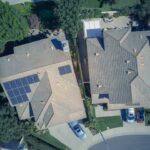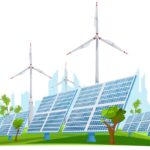Solar panels are often hailed as the stars of any solar energy system, but they don’t work alone. An essential part of this team is the solar inverter—a crucial device that bridges the gap between the energy produced by your solar panels and the electricity you use at home. While panels convert sunlight into power, the inverter ensures energy is usable in your home. Let’s dive deep into what is a solar inverter, how it works, and why choosing the right one is critical to maximizing the efficiency of your solar setup.
What is a Solar Inverter?
A solar inverter might sound complicated, but its role is pretty straightforward. In the world of solar energy, it’s responsible for converting the electricity generated by your solar panels—known as direct current (DC)—into the alternating current (AC) that powers your home.
Here’s why that conversion matters: Solar panels produce DC power, which is great for charging batteries but not ideal for running household appliances. Most devices in your home—everything from your lights to your refrigerator—require AC to operate. Without the inverter, your solar system would be useless for day-to-day home use.
So, a solar inverter takes that raw, unrefined solar energy and transforms it into something your home can use to keep everything running smoothly.
You May Also Like: How Long Do Solar Batteries Last?

How Does a Solar Inverter Work?
The solar energy process starts with your solar panels capturing sunlight. When sunlight hits the panels, they generate DC electricity. However, as mentioned earlier, DC isn’t suitable for powering your home directly. This is where the inverter comes into play.
The DC electricity flows from the solar panels into the inverter. The inverter’s job is to quickly and efficiently convert this DC into AC using an inversion process. Inverters are equipped with sophisticated technology to do this with impressive efficiency, often achieving conversion rates as high as 97-98%.
Once the electricity is converted to AC, it’s ready to be used by all the appliances in your home. If your solar system produces more energy than you need, that excess power can be sent back to the grid (if you’re connected to a grid-tied system) or stored in a battery for later use in an off-grid or hybrid system.
You May Also Like: Mastering Local SEO for Real Estate Agents: A Complete Guide
Different Types of Solar Inverters and Their Advantages
Not all solar inverters are the same. Several types are available, each with its strengths and weaknesses, depending on the design of your solar array and specific energy needs. Let’s take a look at the most common types:
String Inverters
String inverters are the most common type and are often referred to as the “workhorses” of solar power systems. They are typically used in small—to medium-sized residential setups.
How they work: In a string inverter setup, multiple panels are connected in a series, forming a “string.” The DC power generated by each panel flows through the string to a single inverter, which converts the electricity to AC.
Pros:
- Cost-effective, as there’s only one inverter to install and maintain.
- Easy to monitor and service, as the inverter is usually installed on a wall in an accessible location.
Cons:
- The performance of the entire system can be impacted if just one panel underperforms due to shading or dirt.
- It is not ideal for complex roof designs where panels face different directions.
Optimized String Inverters
Optimized string inverters offer a slight upgrade using power optimizers to enhance energy efficiency.
How they work: Power optimizers are installed at each panel, ensuring each one operates independently. This helps mitigate the issue of shading or a single panel underperforming in a string system.
Pros:
- Improved efficiency over standard string inverters, especially for systems with partial shading.
- Allows for more advanced monitoring at the panel level.
Cons:
- More expensive than traditional string inverters due to the added hardware.
- Each optimizer adds point of failure.
You May Also Like: Simple Ways to Unlock a Growth Mindset in Your Daily Life
Microinverters
Microinverters take panel-level optimization a step further by converting DC to AC directly at the panel.
How they work: Unlike string inverters, where a single inverter serves multiple panels, microinverters are installed on each solar panel. This means that the DC-to-AC conversion happens at the source, making the system more flexible and efficient.
Pros:
- Maximizes energy production at each panel, making it ideal for complicated roof designs or partial shading.
- Enhanced monitoring and troubleshooting capabilities, as each panel operates independently.
Cons:
- Generally, it is more expensive than string inverters due to the higher number of inverters needed.
- Maintenance can be more challenging since microinverters are installed on the roof.
Hybrid Inverters
Hybrid inverters are a more advanced option that combines a solar inverter with battery storage capabilities.
How they work: In a hybrid system, the inverter can handle power conversion from solar panels and a battery storage system. This allows you to store excess energy during the day and use it when your panels aren’t producing, such as at night.
Pros:
- It allows for energy storage, giving you more control over how and when you use your solar power.
- It can reduce reliance on the grid and lower electricity costs.
Cons:
- More expensive than string or microinverters.
- May only be necessary for some solar systems if you plan on adding battery storage.
Why Choosing the Right Inverter Matters
Selecting the right inverter can significantly improve the overall performance of your solar power system. The type of inverter you choose will depend on factors like the design of your solar array, whether your roof experiences shading, and your budget.
A standard string inverter is often the most cost-effective option for simple setups where shading isn’t an issue. However, if your roof has shading or you plan to expand your solar system, investing in microinverters or a hybrid inverter might be worth the higher initial cost.
Final Thoughts
Solar inverters are essential in making solar energy usable in our homes. Whether you’re just starting with solar or looking to upgrade your existing system, understanding the different types of inverters and how they work will help you make a more informed decision. Solar technology continues to evolve, and inverters are no exception, offering more efficiency, better monitoring, and more innovative energy management options than ever before.
Do you have more questions about what is a solar inverter or solar energy in general? Feel free to contact us or comment below—we’re here to help you make the best decisions for your solar project!






Comment (01)